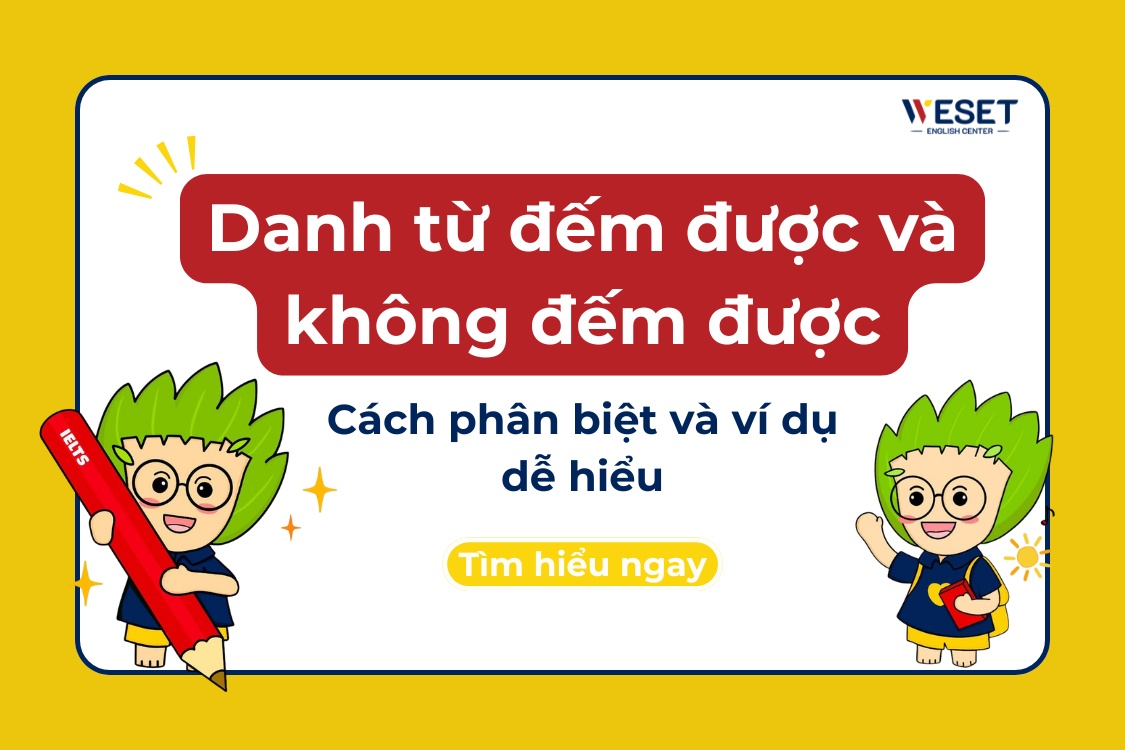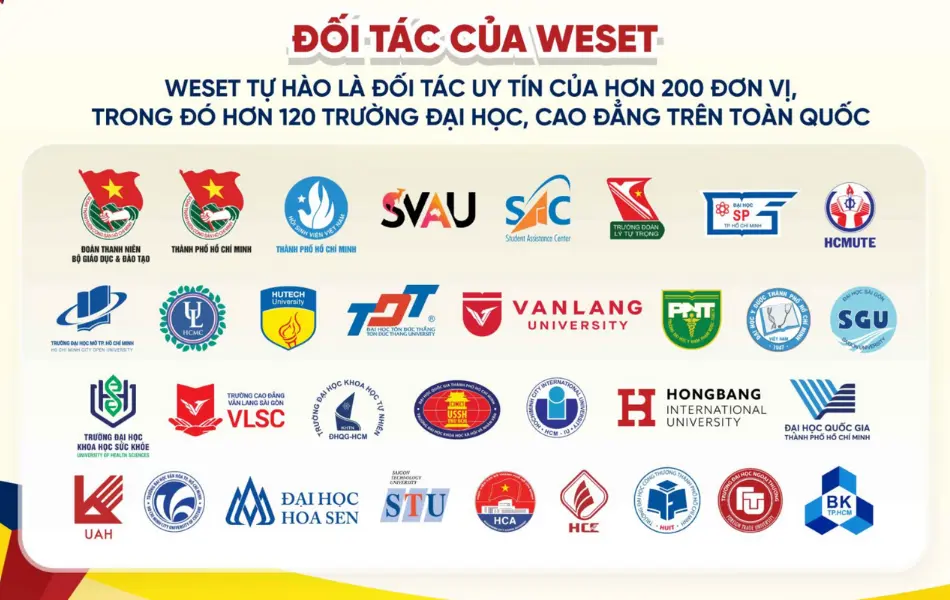Trang chủ Blog Blog IELTS IELTS Writing | Tips luyện thi và tài liệu PDF [MIỄN PHÍ]
IELTS Writing | Tips luyện thi và tài liệu PDF [MIỄN PHÍ]
- Jonathan M. Pham
- Blog IELTS
MỤC LỤC
IELTS Writing là một phần thi then chốt, đòi hỏi bạn phải chứng minh khả năng viết lách, lập luận và sử dụng ngôn ngữ học thuật. Nhiều thí sinh thường lo lắng vì phần này vừa cần tư duy logic, vừa đòi hỏi vốn từ vựng phong phú và khả năng diễn đạt rõ ràng. Bài viết này sẽ giúp bạn nắm rõ cấu trúc, cách ôn luyện, mẹo làm bài hiệu quả và đặc biệt là cung cấp trọn bộ tài liệu IELTS Writing PDF miễn phí cực kỳ hữu ích.
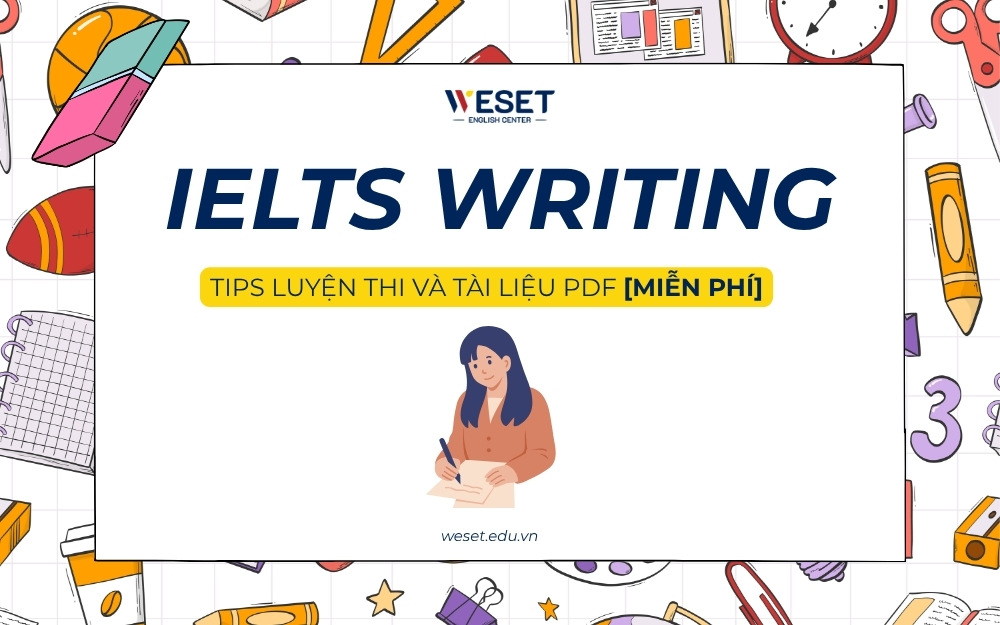
Tips luyện thi và tài liệu ôn luyện IELTS Writing
Sơ lược về IELTS Writing
Cấu trúc phần bài thi IELTS Writing
Bài thi IELTS Writing kéo dài 60 phút và bao gồm 2 phần chính: Task 1 và Task 2. Đối với IELTS Academic, Task 1 yêu cầu mô tả, phân tích biểu đồ hoặc quy trình, trong khi IELTS General Training thường yêu cầu viết thư. Task 2 ở cả hai dạng thi đều là viết luận, trả lời một câu hỏi xã hội hoặc học thuật.
Xem thêm: 6 bước học từ vựng IELTS từ thầy Hữu Nhơn
IELTS Writing Task 1
Trong IELTS Writing Task 1, thí sinh cần viết tối thiểu 150 từ. Đây thường là phần mô tả biểu đồ, bản đồ hoặc quy trình đối với IELTS Academic. Với IELTS General Training, bạn sẽ được yêu cầu viết thư trang trọng, bán trang trọng hoặc thân mật tùy tình huống. Mục tiêu là kiểm tra khả năng trình bày thông tin một cách rõ ràng, logic và chính xác.
Xem ngay: IELTS Writing Task 1 Vocabulary
IELTS Writing Task 2
IELTS Writing Task 2 yêu cầu viết ít nhất 250 từ dưới dạng một bài luận. Đây là phần chiếm nhiều điểm hơn Task 1, và thường được xem là “cơn ác mộng” với nhiều thí sinh. Bạn sẽ phải đưa ra lập luận, phân tích vấn đề, so sánh quan điểm hoặc đề xuất giải pháp cho một chủ đề xã hội hoặc học thuật. Đây cũng là nơi để bạn thể hiện kỹ năng lập luận và sử dụng từ vựng nâng cao.
Có thể bạn quan tâm: 5 dạng Writing Task 2 thường gặp
Thang điểm (band score) IELTS Writing
| 4 Tiêu chí | Chi tiết |
|---|---|
| Task Achievement / Response | Hoàn thành yêu cầu đề bài; trả lời đầy đủ, phù hợp với loại bài (Task 1/Task 2). |
| Coherence and Cohesion | Sự mạch lạc và liên kết giữa các ý, sử dụng đoạn văn, nối ý và tổ chức bài hợp lý. |
| Lexical Resource | Vốn từ vựng: độ đa dạng và chính xác từ ngữ, collocation và từ chuyên dụng. |
| Grammatical Range and Accuracy | Phạm vi và độ chính xác ngữ pháp: cấu trúc câu, thì, chia động từ và lỗi ngữ pháp. |
Mỗi tiêu chí chiếm 25% tổng điểm, sau đó cộng lại và làm tròn theo thang điểm IELTS.
Làm sao để đạt điểm cao trong IELTS Writing
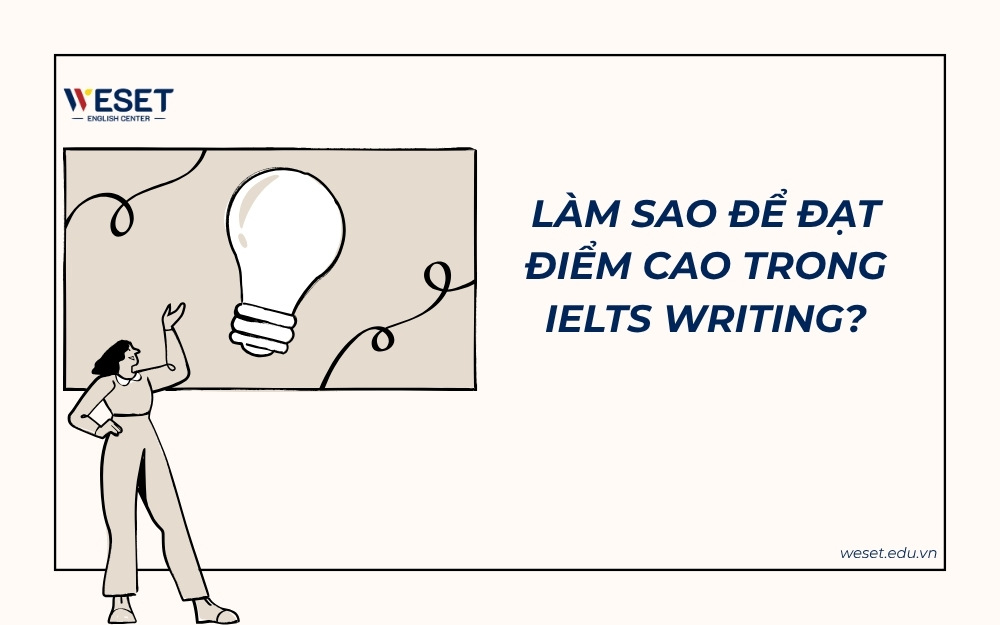
Cách đạt điểm cao trong IELTS Writing
Đừng quên lập dàn ý
Một lỗi phổ biến là nhiều thí sinh lao vào viết ngay mà không lập dàn ý. Hãy dành 5 phút để phác thảo cấu trúc bài, bạn sẽ tiết kiệm thời gian và tránh viết lan man.
Sắp xếp ý tưởng
Ý tưởng cần được trình bày theo logic: mở bài, thân bài, kết bài. Trong mỗi đoạn, một ý chính phải được làm rõ, có ví dụ minh họa và phân tích. Việc này giúp người chấm dễ dàng theo dõi lập luận của bạn.
Chú ý đến ngữ pháp và dấu câu
Dù ý tưởng hay đến đâu nhưng lỗi ngữ pháp liên tục sẽ khiến bạn mất điểm nặng. Hãy đặc biệt lưu ý đến thì động từ, mạo từ và dấu câu. Một dấu phẩy sai có thể làm người đọc hiểu nhầm ý.
Đa dạng hóa từ vựng
Sử dụng từ vựng phong phú sẽ giúp bạn ghi điểm cao ở tiêu chí Lexical Resource. Tuy nhiên, đừng lạm dụng từ khó nếu bạn không chắc chắn về cách dùng. Hãy ưu tiên chính xác hơn “khoe” từ vựng.
Thay đổi cấu trúc câu
Trộn lẫn câu đơn, câu ghép và câu phức để tạo nhịp điệu tự nhiên cho bài viết. Một bài chỉ toàn câu ngắn sẽ bị chấm thấp về sự đa dạng ngữ pháp.
Xem ngay: 5 Cấu trúc ngữ pháp IELTS Writing giúp bạn nâng band nhanh chóng
Sử dụng các từ và cụm từ liên kết
Các cụm từ như “on the other hand”, “in contrast”, “as a result” giúp bài viết trôi chảy và mạch lạc hơn. Đừng quên nhưng cũng đừng lạm dụng, kẻo bài viết trở nên gượng ép.
Đọc lại & chỉnh sửa trước khi nộp bài
Dành 5 phút cuối cùng để rà soát lỗi chính tả, ngữ pháp và từ vựng. Đây là bước nhỏ nhưng có thể giúp bạn tránh mất điểm oan uổng.
Luyện tập và luyện tập
Không có con đường tắt cho IELTS Writing. Bạn cần viết thật nhiều, tham khảo bài mẫu IELTS Writing, và quan trọng nhất là nhận feedback từ giáo viên hoặc bạn bè, người thân có kinh nghiệm.
Tự luyện viết IELTS tại nhà sao cho đúng
Tự học IELTS Writing hoàn toàn khả thi nếu bạn có kế hoạch. Hãy bắt đầu từ việc đọc bài mẫu, phân tích cấu trúc, sau đó viết lại theo cách của mình. Ngoài ra, việc tham khảo tài liệu IELTS Writing PDF miễn phí cũng là cách tiết kiệm chi phí nhưng vẫn hiệu quả.
Bên cạnh đó, bạn nên tập trung luyện viết theo từng dạng bài (Task 1, Task 2) thay vì viết ngẫu hứng. Việc bám sát tiêu chí chấm điểm của IELTS Writing như Task Response, Coherence & Cohesion, Lexical Resource và Grammatical Range & Accuracy sẽ giúp bạn viết đúng hướng và cải thiện nhanh hơn.
Một mẹo nhỏ là hãy đặt thời gian giới hạn khi viết để làm quen với áp lực thi thật. Sau khi hoàn thành, bạn có thể tự so sánh với bài mẫu band cao hoặc nhờ giáo viên/ bạn bè giỏi tiếng Anh góp ý. Việc sửa bài liên tục sẽ giúp bạn nhận ra lỗi sai thường gặp và nâng dần điểm viết.
Tài liệu Hacker IELTS Writing PDF miễn phí
Nếu bạn cần một bộ tài liệu chi tiết, có hệ thống thì Hacker IELTS Writing là lựa chọn đáng cân nhắc. Bộ sách này chia nhỏ từng dạng bài, hướng dẫn cách phân tích đề, lập dàn ý và viết bài. Bên cạnh đó, sách còn cung cấp nhiều bài mẫu IELTS Writing chất lượng để tham khảo.
| Thông tin | Chi tiết |
|---|---|
| Tên sách | HACKER IELTS WRITING BASIC |
| Loại file | |
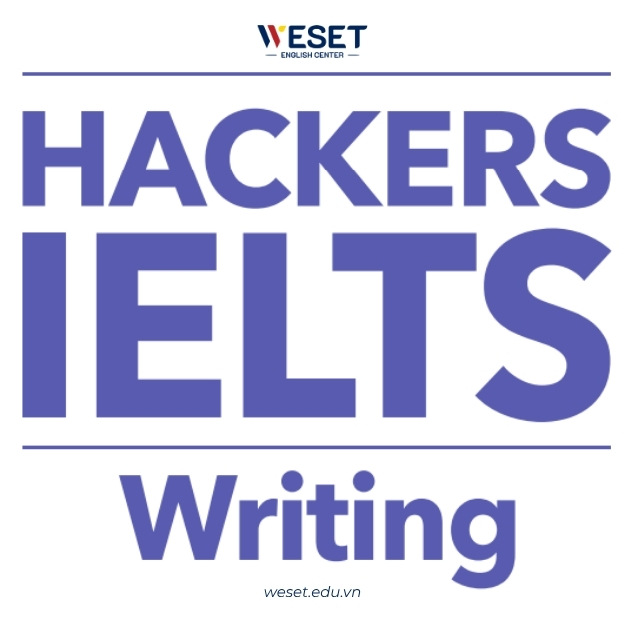 |
Hacker IELTS Writing là cuốn sách luyện thi thuộc bộ Hackers IELTS (Hàn Quốc), chuyên về kỹ năng Viết. Sách tập trung hướng dẫn chiến lược làm bài và cung cấp các bài mẫu học thuật cho cả Task 1 và Task 2, giúp người học ở trình độ cơ bản xây dựng nền tảng và nâng cao band điểm. |
| Link tải | SÁCH HACKER IELTS WRITING PDF |
Các nguồn tài liệu tham khảo khác
Bên cạnh Hacker IELTS Writing PDF, bạn có thể tìm thêm tài liệu IELTS Writing từ Cambridge IELTS, Barron’s hoặc bộ đề từ các trang học thuật uy tín. Điều quan trọng là chọn nguồn tài liệu đáng tin cậy để không học sai.
Luyện thi IELTS – nâng band nhanh chóng cùng WESET
Nếu bạn cảm thấy tự học chưa đủ, việc tham gia khóa học luyện thi tại một trung tâm tiếng Anh uy tín sẽ là giải pháp hợp lý. Tại WESET, học viên được hướng dẫn chi tiết từng bước trong IELTS Writing Task 1 và Task 2, đồng thời nhận feedback cá nhân hóa. Đây là cách giúp bạn tiến bộ nhanh và đạt band điểm mong muốn.
Việc ôn luyện IELTS Writing không hề đáng sợ nếu bạn nắm vững cấu trúc, luyện tập thường xuyên và tận dụng tốt các tài liệu IELTS Writing PDF. Hãy coi đây là hành trình nâng cao kỹ năng ngôn ngữ thay vì một “kỳ thi khắc nghiệt”. Biết đâu, bạn còn khám phá được khả năng viết lách ẩn giấu của chính mình nữa đấy!
WESET English Center – Luyện thi tiếng Anh cam kết đầu ra

WESET English Center
WESET English Center – trung tâm luyện thi tiếng Anh cam kết đầu ra tại TP HCM. Với nhiều năm kinh nghiệm trong lĩnh vực đào tạo tiếng Anh và luyện thi IELTS, WESET tự hào là trung tâm luyện thi IELTS, luyện thi TOEIC chuyên sâu uy tín giúp hàng ngàn học viên đạt được ước mơ du học, định cư và phát triển sự nghiệp
Những điều chỉ có tại WESET
- Chất lượng giáo viên: Đội ngũ giáo viên có IELTS từ 7.5+ là Cử nhân trường ĐH Sư phạm/Thạc sĩ chuyên ngành giảng dạy tiếng Anh/Ngôn ngữ, sở hữu chứng chỉ nghiệp vụ sư phạm/TESOL/CELTA.
- Cam kết IELTS đầu ra đến 8.0+ bằng văn bản.
- Tổ chức hoạt động ngoại khoá: workshop chuyên môn; hoạt động tiếng Anh 100% hàng tuần (Speaking club); sự kiện chia sẻ kiến thức, kinh nghiệm học tiếng Anh, du học,…
- Đối tác uy tín: Là đối tác của UniMedia – đơn vị tổ chức cuộc thi Hoa hậu Hoàn vũ Việt Nam (Miss Cosmo Vietnam), Đoàn TN Bộ Giáo dục và Đào tạo; Thành Đoàn TP.HCM; Thành Đoàn TP.Thủ Đức; Hội Sinh viên Việt Nam TP.HCM; Hội Sinh viên Việt Nam tại Úc; Trung tâm Hỗ trợ Học sinh, sinh viên TP.HCM; Quận Đoàn 1,3,4,5,6,7,8,10, Bình Tân; Các trường ĐH như trường Đại học Sư phạm TP.HCM, trường Đại học Luật TP.HCM, trường Đại học Mở TP.HCM và hơn 120 trường Đại học – Cao đẳng trên toàn quốc.
- “Study Space” – không gian ôn tập với Trợ giảng và tài liệu miễn phí sau giờ học.
- Tặng gói học bổng toàn phần 100%* khi du học Anh, Úc, Mỹ, …
- Lớp online với mô hình đặc biệt 1 Giáo viên – 3 Trợ giảng, giáo trình giảng dạy sinh động, ứng dụng vào thực tế.
- Tổ chức thi thử mỗi tháng để học viên làm quen với không khí phòng thi thật.
- Tổ chức các kỳ thi giữa kỳ và cuối kỳ giúp các bạn xác định năng lực tiếng Anh.
- Giảm lệ phí thi IELTS còn 3.999.999 đồng khi đăng ký qua WESET*.
- Hệ thống Learning Portal – cổng thông tin học viên giúp học viện ôn luyện, cập nhật tin tức học tập nhanh chóng, hiệu quả.
- Số giờ học cao nhất thị trường, đến 72 giờ/khoá.
- Hoạt động ngoại khóa đa dạng: Giúp học viên thực hành tiếng Anh trong môi trường thực tế, phát triển toàn diện.
✅ Hơn 200 đơn vị đối tác đồng hành, trong đó hơn 120 trường Đại học & Cao đẳng đã ký kết tại TP.HCM và cả nước
✅ Cam kết IELTS/TOEIC/PTE đầu ra bằng văn bản. Hỗ trợ lệ phí thi lên đến 100%
✅ Đội ngũ giáo viên có điểm IELTS trung bình từ 8.0+, có chứng chỉ sư phạm/ TESOL/ CELTA
Trung tâm luyện thi IELTS tại Việt Nam
Chuyên gia luyện thi IELTS trình độ cao
Phiên bản giáo trình cá nhân hoá
Lộ trình luyện thi & thiết kế riêng theo nhu cầu
KHÓA HỌC CAM KẾT ĐẦU RA
Thông tin liên hệ WESET
Hotline: 028 38 38 38 77
Email: support@weset.edu.vn
Website: https://weset.edu.vn/
Để lại thông tin ngay hoặc đăng ký tư vấn tại đây.WESET tự hào là đối tác uy tín của hơn 200 đơn vị, trong đó hơn 120 trường đại học, cao đẳng trên toàn quốc.
Hệ thống trung tâm Anh ngữ WESET

Chi nhánh Hồ Chí Minh
Địa chỉ: Trung Tâm Anh Ngữ WESET
Hotline: 028.38.38.3877
Tỉnh thành: Trụ sở chính



